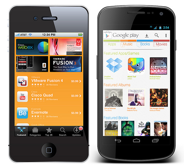The Rise of In-App Advertising: Why Mobile Marketers are Turning to This Lucrative Platform by Megan Totka
 In a world dominated by smartphones, apps are the next big thing. According to online digital marketing magazine eMarketer, U.S. adults spend more media time on their mobile devices than with newspapers and magazines combined — and 2012 data from Nielsen [PDF link] found that 64 percent of mobile time is spent on apps.
In a world dominated by smartphones, apps are the next big thing. According to online digital marketing magazine eMarketer, U.S. adults spend more media time on their mobile devices than with newspapers and magazines combined — and 2012 data from Nielsen [PDF link] found that 64 percent of mobile time is spent on apps.
It’s no wonder marketers are catching on to the benefits of in-app advertising.
How In-App Advertising Works
Just as with online advertising, in-app ads can take several forms, including:
- Small, text-only ads with links, similar to Google AdWords or Facebook ads, that appear at the top or bottom of the screen while the app is running
- Mobile-specific banner ads designed for smaller screens
- Full-screen interstitial (“interrupt”) ads that are timed to run for a number of seconds and appear during app loading screens
- Larger ads that appear between levels in game apps
- Post-purchase ads that appear after a user has completed a mobile transaction
- In-app “offer walls” that contain several different ads, often used in game apps with rewards such as in-game currency or consumables
In-app advertising is beneficial to both marketers and app developers. On the developer/release side, app makers have the potential to earn more by releasing free apps with paid advertising, with projected total revenues exceeding $860 million by 2014. Mobile device owners are also into free apps, particularly tablet users: a study from the Online Publishers Association [PDF link] found that 54 percent of tablet owners prefer free apps with advertising, as opposed to paid apps.
Best Practices for Using In-App Advertising
Purchasing in-app advertising can be very effective, if you use strategies that don’t annoy consumers. The recall rate for app ads is higher than any other digital medium at 54 percent, with the second highest—online ads—at just 40 percent. It’s a great way to strengthen your branding and improve top-of-mind among mobile users.
How can you take advantage of this powerful marketing strategy? Here are a few tips to keep in mind:
- Keep your terms transparent and visible in your ads, to avoid having consumers feel tricked or ripped off when they click through.
- Make your in-app ads as rich and engaging as possible. Ads that feel like they’re part of the app experience perform better than simple ads that clearly have no common threads with the app itself.
- Whenever possible, advertise within games. Game apps generate higher click-through rates than other types of apps, especially those that tie directly into the app with in-game currency offers.
- If you’re developing your own free app for your business that features advertising, don’t limit functionality of the app by forcing consumers to make a purchase before they can unlock certain features. This will result in negative marketplace ratings and decreased downloads.
Get creative and in-app advertising can pay off for you. How will you advertise your business to a big mobile crowd?
[Editor’s note: if you’re interested in learning more about how to use mobile for your busines, register to receive a free copy of my new special report, “Digital Hotel Marketing in a Multiscreen World,” produced in conjunction with Vizergy, here. While it’s targeted to the hospitality industry specifically, most of the lessons apply across verticals.]You might also enjoy some of our past coverage of the social, local, mobile web, including:
- Today and Tomorrow: Mobile and the Changing Customer Journey
- What’s the Future of E-commerce? Look to the Past to Find Out
- Why You’re Slowing the Growth of Mobile E-commerce
- 4 Fundamental Truths About the Future of E-commerce
- And 4 E-commerce Changes Worth Watching
- Is E-commerce Destined to Win?

Comments (0)